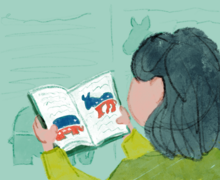MySlice’s pronoun limits leave trans, gender-expansive students feeling unseen
Illustration courtesy of The OutCrowd
Syracuse students using non-binary pronouns feel that their gender expression is limited by MySlice's pronoun choices.

This piece was written for The OutCrowd, Syracuse University’s only student-run LGBTQIA+ publication, in collaboration with The Daily Orange. Read The OutCrowd’s fall 2021 issue here.
As an incoming freshman to Syracuse University, the part of college I was most looking forward to was using this new environment to fully come out as agender, using they/she pronouns. Throughout my college admissions process, SU had been one of the schools that most consistently oriented itself as a safe space for LGBTQIA+ students, touting its wide range of resources and emphasis on an inclusive community. I entered my first week of classes excited to introduce myself with my chosen name and pronouns, able to finally turn over a new leaf.
Within two days, I was disillusioned. Out of six classes this semester, with five being seminar-sized, I only had one professor ask us to introduce ourselves with our pronouns. I was disappointed, until my First-Year Seminar professor informed our class about the setting in MySlice that allowed students to indicate their preferred pronouns. Finally, I had a way to make sure that my pronouns would be known and respected. Except, I didn’t.
When I logged into MySlice and found the pronoun tool, I clicked on the drop down and was greeted with six options: she/her, he/him, they/them, ze/hir, use my name and ask me. For a brief moment, I thought maybe the menu would allow me to select more than one option, but this quickly proved untrue. The tool I thought would be the holy grail of inclusion and respect in my classes (and beyond) simply did not have a space for my identity.
I understand and respect that mixed pronouns, or the use of more than one set of pronouns by an individual, are a relatively new practice in the mainstream. They’ve gained prominence in the past year or so and thus may not be one of the more well-known pronoun options. Mixed pronouns, though recent, are also prevalent. A great deal of SU students use mixed pronouns, some of whom have shared similar experiences and feelings surrounding this lack of awareness. One of those is Ben Webster, a freshman who uses he/they pronouns, who felt “a bit less seen” by MySlice’s exclusion. “It’s a big topic — but I was surprised at how few options there were,” they said.
This sentiment is shared by Evelina Torres, another member of the class of 2025 who uses she/they pronouns. When asked about their feelings on the tool, she expressed frustration over the ways in which it serves as a limitation on her gender identity and expression, saying “I feel very invalidated. … Sometimes I feel that I will never be able to present and be seen as genderqueer. To me, it cements the idea that I must be certain in my gender, or that gender expansiveness is unprofessional.”
These students also expressed that very few, if any, professors have asked for their pronouns. One member of the class of 2022 who uses they/he/ze pronouns said that only one of their professors had asked the class to share pronouns, which was about the same for most other students interviewed.
Many students who used mixed pronouns noted that even when professors did ask for pronouns, they then defaulted to using only the student’s binary pronoun (if they used he/they, she/they, etc.) or the pronoun that best aligned with the student’s outward appearance, even if that was not the student’s only pronoun. It’s clear that many faculty members don’t have much experience with mixed pronouns — which is perfectly understandable, considering how new they are. But, this serves as another example of the continued erasure that students who use mixed pronouns face on campus. If the university updated the pronoun tool and provided faculty with basic information on mixed pronouns, it would take the onus off of already marginalized students to have to explain their identities every semester.
MySlice’s lack of inclusive pronouns is not the only problem with the pronoun tool. One SU professor informed me that he had no idea he could access students’ preferred pronouns through MySlice. He described how he has, in some semesters, bought pronoun pins for his students to indicate their chosen pronouns in class and beyond. While this is an admirable solution, it shouldn’t have to be one. The university needs to not only update the MySlice pronouns tool, but also to make it clear to students and professors how to find it and how to use it in a classroom setting. Until it does so, it is failing our trans and gender expansive community while simultaneously preaching the prioritization of inclusivity.
The update would not need to be complex, either. The university could follow a model similar to that of Instagram, which implemented a pronoun selection tool where users can type in up to three pronouns of their choice. On the platform there is a list available for users to auto-fill their pronouns, but users are also free to manually enter other pronouns. An even simpler solution would be to program the MySlice drop down to allow multiple selections, or to add an “other” option that allows students to manually enter their pronouns. A small fix, but it would provide a big impact, creating space for trans and gender expansive students to be respected and visible. And that, to me, is what inclusivity really means.
Published on March 10, 2022 at 2:34 am






